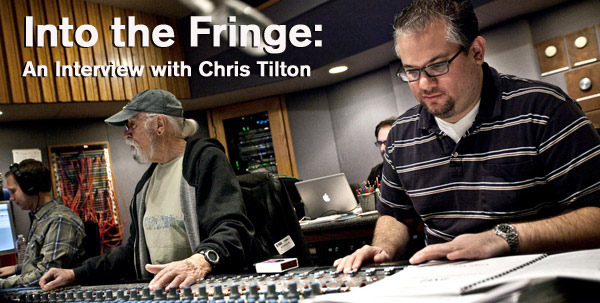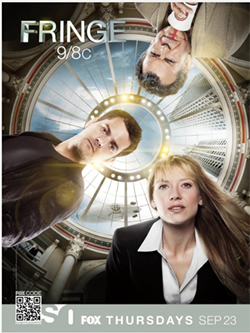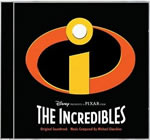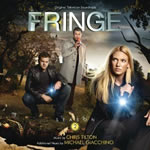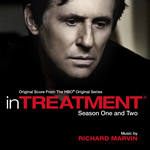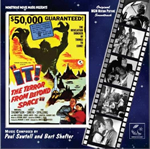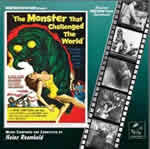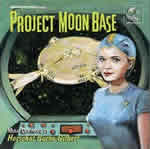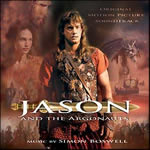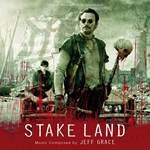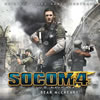
 |
Soundtrax: Episode 2011-6
June 3, 2011By Randall D. Larson
Photo: Josh Negrin After serving a valuable apprenticeship with Michael Giacchino, composer Chris Tilton emerged into his own in the second season of J. J. Abram’s sci-fi TV drama, FRINGE (recently released on CD by Varese Sarabande). Interviewed earlier this year while preparing the soundtrack album, Tilton described his collaborative efforts with Giacchino and the process of scoring FRINGE.
Q: How did you get into scoring for films?
Chris Tilton: The first thing I did when I moved out here was start working for Michael Giacchino as his assistant. This was back in summer of 2001. He had just got back from recording MEDAL OF HONOR: FRONTLINE at the time. That he started on ALIAS and he needed some more regular assistant work, like score prep, getting the scores ready for the shows each week, and it just kind of went from there.
Q: How did you make that connection initially? What was your musical background?
Chris Tilton: I was a music composition major at University of the Arts in Philadelphia. I’d been a video gamer since the ‘80s. I first heard of Michael when JURASSIC PARK: LOST WORLD, the video game soundtrack, came out and then subsequently the MEDAL OF HONOR games. He had an email address in the liner notes of MEDAL OF HONOR: UNDERGROUND (I don’t think he has that email address any longer) so I just emailed him out of the blue – “I love your stuff, and would you be willing to listen to any of my stuff?” That was during my last year in college, and I was going out LA just to look for apartments. He responded to my email and I asked if he wanted to meet up for lunch sometime? He said sure. So we did. So a lot of it was just the right timing, because he had never had an assistant before.
Q: What are some of the most important things you learned working with Michael, in terms of preparing for a career of your own?
Chris Tilton: I would say going to the daily sessions each week – seeing what he had written and then hearing it so close after it’s written – was probably the most invaluable experience. Just seeing the notes on the page and then hearing how it comes out, and then next week trying something else. It was a lot of trying little ideas out and seeing how that works. The ideas that didn’t work so well we didn’t do anymore, and then ideas he did like he would do more often. It was a constant feedback, unlike in a movie score where you could be writing for months and then you finally hear it. On the TV show, especially one that uses live musicians each week, it was really, really cool to get that sort of instant feedback. And whatever you learn from that one, you can apply to the next one, and then you can apply to the next one, and so on.
Q: As an orchestrator, what were some of your techniques as far as taking what Michael had written and incorporating some of your own influence, if you were able to do so?
Chris Tilton: It depended on the project. Most of the TV stuff was exactly how he wanted it, so it would just be a matter of me filling in the details of dynamics and things like that. Sometimes when you’re in one of those weeks where you just have to get things done really quickly, every now and then there’d be something that repeats over a certain number of bars, maybe if we just spiked it up every now and then so it’s not just the same thing over and over again. Little things like that, that’s kind of how it started. It kind of just depends. On certain film scores he’s really, really specific about what he wants, in this business you move fast, so he’s like, “I didn’t have time to write any woodwinds, so put some stuff there.”
Q: I would imagine after you’d worked with him for awhile, he began to trust you more, to do little things like that on your own.
Chris Tilton: Certainly. When I started off it really was mostly little assistant work, and then it kind of grew from there. The more I worked for him, the more we figured out what each of us is good at and what we like, and all that kind of thing.
Q: What was your experience when you were feature scoring THE INCREDIBLES?
Chris Tilton: Again, that kind of varied. Tim Simonec was the primary orchestrator on that, as he is for all of Michael’s stuff. As far as I went, it was mostly just slight fleshing out of little things. That score was very, very detailed as to how Michael wanted it. However there were things, if you remember the moment in the movie where he’s reconnecting with his son and they have that sort of montage, Michael just wrote that on piano and then handed it to Tim and said here, have fun, turn it into a big dad thing. So it really varied. He could be extremely detailed, and then on the other hand, if he knows someone is good at something, he likes to let them do that.
Q: Around the same time, you began to get your own gigs scoring video games, such as ALIAS the game and THE INCREDIBLES: RISE OF THE UNDERMINER. How did those come about for you?
Chris Tilton: Those mostly came just out of just working for Michael. For the ALIAS game he just handed it to me and said, “have fun with it and use some of his material from the show thematically, at least.” On RISE OF THE UNDERMINER Michael wrote something like three new themes for that, and I took it from there.
Q: Being a gamer yourself in your own background, how did that help you understand better the dynamics of the kind of music games needed?
Chris Tilton: That stuff was discussed beforehand. You have to work with the kind of audio tools the audio engineer has, and you just work that out beforehand. It depends on the game, on what the game needs, and what kind of tools, programming-wise, you have available. It varies.
Q: How has technology changed over the last seven, eight years since you’ve been doing this, to give you more and better tools to do that?
Chris Tilton: I would say overall the more modern games have the ability to have more simultaneous audio tracks going at once. You can do a lot more complex things where you can break out a single piece of music into stems, which is getting more and more common practice now. The more simultaneous audio stems you’ll be able to stream, the more you can change a single piece of music. Like if you have the brass on one track and the strings on another track and the percussion on another track, you can vary up that same piece of music without stopping and starting a new piece of music. So what you can do depends on the bandwidth the game systems have. One of the most obnoxious things in games is when you start a fight and the music abruptly stops and starts in with fighting music. You fight for fifteen seconds and then that stops and goes back to the other music. It’s not very musical, and doing that over and over can be really obnoxious. But if it’s just the same piece of music that changes slightly, and then changes slightly back, it’s a lot more musical and a lot less jarring.
Q: The other challenge of games is that unlike a movie or a TV score which is fairly linear, in a game you have to have the music read to go in any direction the gamer might take it.
Chris Tilton: Yeah, again it depends on the kind of game it is. If it’s an open world game or a very linear funnel experience, like a CALL OF DUTY game, that game knows you’re going to hit this section at some point. It knows you will hit it. And so you can control the dramatic experience very specifically. If it’s a more open world, you have to I guess be a little more vague sometimes.
Q: Working with Michael on the first season of FRINGE gave you lots of opportunities to compose your own music, and with Season 2 you became primary composer. How did the musical design for that show first originate?
Chris Tilton: FRINGE had a little bit of a rough start, not just musically but it took a while to figure out what the show was really going to be. I did not work on it the first half of the first season. As they were just kind of trying all these different things, Michael asked me, “do you want to try? What would you do with this show, musically?” So I kind of wrote out some ideas and the producers liked what I did, so then I started writing a lot more of the show, and then by Season 2 I was starting to do all of it.
Q: What kind of musical palette are the episode scores based on?
Chris Tilton: When it started out, what the show felt like it needed was drive and momentum. So it was a lot of percussion and synth patterns and sounds and pulsing, because at first when I started with the show, the show was very much about just weird stuff each week. I said “well, on top of that you need to have some kind of live player to bring some kind of human touch to it.” So I decided to have a solo cello and electric guitar complement that. That felt like the vibe of the show – that was the core value of the show to me. It gave me an opportunity to do like what Michael got to do with strings mostly on ALIAS, it allowed me just to try new stuff with the cello each week, and I could learn more about the instrument at the same time. That’s kind of how it started. I did a lot of things with the cello – I would process it like an electric guitar and sometimes it would even sound like one. There’s all this percussion and synth stuff which was cool, but I would say the cello was definitely the soul of the music, and the electric guitar was like the glue that keeps everything together. It’s evolved to be a little more orchestral since then.
Q: The main title for the show was written by J. J. Abrams, but Michael composed a theme which was used in episodes during the First Season. How have you worked with that in Season 2?
Chris Tilton: Yeah, J. J. Abrams has written the title music for every one of his shows, that’s a little thing he likes to do. There was a theme that Michael did that was used from time to time in the first half of the season, but when they were still just trying to figure out what the show was going to be we decided to turn everything around and completely change the sound of the show. A lot of that stuff we had didn’t work really with the new sound, so we started from ground zero. With the exception of a couple themes, the first season was not entirely thematic – it was mostly rhythmic. There was a theme that I had to write because it was sort of a mythology story element that comes in, but it wasn’t until season 2 where I actually started to write themes for all the characters and I can use things like that.
Q: The music in addition to underlining the sense of weirdness and tenseness, you also have the opportunity to enhance the characterizations. How do you treat the characters musically?
Chris Tilton: The easiest thing to compare it to is the traditional leitmotif style of writing. That is a lot like LOST where every character has some kind of thematic identity, even if it was very simple, and it weaves in and out between all this other stuff. That’s kind of how it works in this show. Whatever the characters feel like they need is what I try to do. And actually becoming more thematic was a request from the producers at the beginning of season 2, which I was happy to do because that’s always more fun.
Q: What’s your orchestral palette here? Is it still synths and live music?
Chris Tilton: The sound as it is now on Season 3, still has all the driving synth elements, percussion, and weird sounds and stuff, and we still have the electric guitar and the solo cello, but we also have a viola and cello section and two French horns that play every week. And that’s kind of how the sound of the show was when it got bigger towards the end of season 1, we did have orchestra sessions with violas, cellos, basses, and French horns. That felt to me like the natural evolution for the solo cello and guitar. It kind of stayed that way. Whenever it’s gotten bigger, it stayed with that kind of group.
Q: Even though it’s going into its third season, do you still work closely with J.J. Abrams or has he mostly backed off?
Chris Tilton: Jeff Pinkner and Joel Wyman are the two show runners, so it’s kind of their baby now. It’s kind of like how he co-created LOST but it became the show of Carlton Cuse and Damon Lindelof. It’s kind of the same thing here. Like on LOST, he’s involved in meetings and talking about overall story ideas, and probably the same with Bob Orci and Alex Kurtzman; they also co-created FRINGE. They’ve since gone on to do other things. So I think some of those people are probably involved in planning overall story arc, but as far as the show itself goes it’s pretty much Jeff Pinkner and Joel Wyman’s show.
Q: Well at what point do you get an episode that’s ready to be scored, and how much time do you have to get it done and record it?
Chris Tilton: We usually just have a spotting session when the episode is locked and ready to go. I’ll usually have about three days, sometimes a little more, it depends. Three to five days.
Q: What’s the biggest challenge for you on scoring FRINGE?
Chris Tilton: There was an episode this season that had a mystery-of-the-week that evolved into a mythology kind of thing, and there was conflict between Walter and Peter (Walter is Peter’s father) and one character was pretending to be someone else she’s not, so there were all these inner character conflicts, and it’s been challenging to balance that music. To play all this subtext that’s going on musically has probably been the most challenging thing so far. It’s fun, but it sometimes gets really complicated. There’s a lot of emotions and intentions that are implied through the actors that is not necessarily expressed, and having to try and play all that can get complicated.
Q: Well with the recent release of the soundtrack album of season 2, it is good to hear some of your music on its own. Were you involved in selecting the music that was used?
Chris Tilton: Yeah. I had a rough idea of some of the stuff I started with, and then I whittled it down so it would fit on the CD. I’m normally not a fan of albums that run close to the 80 minute running time of a CD, but on TV shows there’s so much music on one season that it’s harder than you think to whittle it down to, because you’re always going to have to get rid of stuff that you like or that you think people might like. I edited all the music down to what it is on the album.
Q: For the first two seasons, did you and Michael create a complete new score for each episode, or did you re-use any music?
Chris Tilton: No, it was new each week. That’s kind of how it always has been. Certain shows – especially procedural shows – aren’t about characters but about the plot. They used to do that in the old days when they had 39 episodes in a season, and they just crank those things out so fast that you just didn’t have time to, especially back before there were computers. But it’s pretty much the norm now, especially for hour dramas, to have your own score. I mean there may be the occasional cue that gets put in there that’s an older cue, but it’s usually just because what I did wasn’t working quite right, and the easiest thing to do was just to find another one that worked.
Q: Are there any other folks that involved in the music? I understand guitarist Mike McCready of Pearl Jam wrote some music for the ‘Northwest Passage’ episode?
Chris Tilton: He was just a fan of the show. His agent reached out to the show runners, Jeff Pinkner and Joel Wyman. Jeff approached me and said, “Mike McCready would be interested in doing something, what do you think?” So we tried to figure out which episode would make sense to have someone else brought in to play on it. The tricky thing was that he’s a guitar player, and we already had a guitar player who plays every week, so I didn’t want to just bring him in and have him do the same thing that our regular guitar player does; that would be kind of pointless. When it came out that it was going to be this episode that focused just on Peter and had kind of a different vibe to it – it could be a standalone episode that started a theoretical spin-off that followed just Peter around – we said this would be a good episode to have him do some stuff. I had already written a theme for Peter for previous episodes, and I gave that to him early on, and he just came up with some ideas riffing on Peter’s theme. We let the editors see if they could work in some of those things – most of them didn’t, but a few of those ideas are in there. Then I picked certain scenes for him to start on – he looked at the episode with me and I said, “this scene, this scene and this scene and this scene; why don’t you do just some rough ideas that I can incorporate and turn into a cue.” So he did that, and then I tweaked around with it and wrote a cue around some of the things ideas that he did, and what resulted is what you heard in the episode.
Q: Chad Syder is also credited with working on some of the episodes…
Chris Tilton: He’s the one who started the first half of the season. Michael did the pilot and he did a cue or two on each episode after that, but just to mix it up he asked me to do something totally different. They were trying to do stuff and it wasn’t totally working. A lot of the parts of the show weren’t totally working early on. And he did do some music in the rest of season 1 while I worked on it.
Q: Ever since the second season, it’s just been you, right?
Chris Tilton: Correct.
Q: Where do you go from here?
Chris Tilton: Well, I don’t think anybody can ever predict what they will or won’t do. I mean, I would certainly love to get into doing film scores, as most do. But you know, when or if an opportunity comes along, we’ll all go from there. I’m certainly happy for now just to keep going from FRINGE.
_______________________________________________________________________________
New Soundtracks Releases of Note
APPASSIONATA/Piero Piccioni/Quartet
Spain’s Quartet Records has released an expanded soundtrack album of Italian composer Piero Piccioni’s lush, melodious music for this 1974 erotic romance. Piccioni is known for a master of Europop lounge music throughout the ‘60s, ‘70s, and ‘80s, although he also contributed to Italian Westerns and giallo thrillers, and this score is richly flavored with his gift for popular melodies and youthful romantic passion. Quartet’s 2-CD release, limited to only 500 copies, contains the original LP album tracks on CD 1, with the actual film score, including alternate takes and outtakes, on CD 2. The music is vividly tuneful and sensually alluring, made up of a handful of melodies that are reprised in a variety of different moods throughout the score (as is most evident in the second disc where Piccioni’s style of theme-and-variation is much more apparent). As writer Gergely Hubai writes in his explanative liner notes, Piccioni’s score “may seem superficial and purely sexual at first listen, it actually plays a very important part in introducing new emotions to [the film’s character] relationships.” Hubai also notes how much Italian film music is the ‘60s and ‘70s was not written to specific scenes but comprised a selection of themes to cover the type of sequences that needed music; thus scores such as this one resembled less dramatic film scores than easy listening albums (and why music is subject to so many abrupt edits in Italian films of this era, since they weren’t written to fit specific scene timings and were simply chopped off when the scene was over). Thus much Italian film music is better served on record albums than in the films for which it was written; in the case of APPASSIONATA we have both worlds effectively served: the re-recorded and expanded musical numbers as released on the 11-track LP by Cinevox in 1974, intended largely as a standalone listening experience, and also the wealth of variations (34 tracks) recorded for the film itself, and provided to the film’s music editor to be inserted into the picture where needed. The latter’s arrangements are similarly breezy but they seem much more direct, more suited to the film screen than the living room stereo, and the diversity of arrangements of Piccioni’s melodies are quite intriguing and articulate. For example, the score’s title tune, represented in two arrangements on the original album, are presented in half a dozen variations, including a “funny mood sax” rendition, a “mystic mood” version, as a “discotheque” routine, a quirky “funny moog” synth version, and a “beat mood” variant. The other themes are subject to a similar array of interpretations (“La Chatte A La Satie”) is especially compelling in its multiplicity of shapes. It’s fascinating how malleable these melodies can be and how Piccioni makes a wealth of new cues out of a handful of basic motifs. Hubai’s liner notes are valuable in helping make sense of it all and providing background data of the film and its composer.
IN TREATMENT/Richard Marvin/Lakeshore (digital only)
Richard Marvin (SURROGATES, TV’s SIX FEET UNDERand WITHOUT A TRACE) composed the music for the provocative HBO series, IN TREATMENT (debuted 2008). Adapted from a popular Israeli series, the series follows psychoanalyst Paul Weston (Gabriel Byrne, who won a Golden Globe® for his role) through his week, capturing sessions with his patients. Lakeshore has released a soundtrack (20 tracks, 39 mins) of music from the show’s first two seasons. Throughout Marvin has based his score on funky vibe of various keyboards, rhythm guitars, and hand drums, building a quirky, almost playful backdrop for the character and his therapeutic sessions, which variations developed into motifs for the characters whose stories populate each episode. Significantly, the score focuses on Weston’s patients, coloring their needs and rapports with him; there is no specific theme for the psychoanalyst himself; instead he tends to adopt the music written for his patients as he reacts to and invests himself into their various issues. “In Season 1 there were specific themes for each character, developed over the course of the season,” Marvin said. “Season 1 also had more of a ‘vibey, groovy’ end credits.” By the second season, Dr. Weston has been through a divorce and has relocated to Brooklyn, where he sees patients in his home. “In the 2nd season, the producers were less concerned with the thematic development and character themes,” explained Marvin. “There was more of an effort to be more transparent and sparse, especially on the underscore cues.” As a result the Season 2 score features more conventional orchestrations. The mix of primarily atmospheric, sunlit acoustic material is enjoyable, reflecting not so much the show’s dramatic struggles but setting down a running ambiance of percussive rhythms that mirror the show’s contemporary environment and the professional demeanor (and barely hidden ghosts) of its protagonist. The score occasionally reflects the characters psychological disarray (as in “Gina - Week 6 - Season 1”) but more often treats them as interesting personalities with a colorful, light urban vibe. The album sequencing intermingles cues from both seasons, and given the change in musical approach between the first and second season this is a good decision, providing a listening experience that is mixed without proffering an abrupt shift in style when Season 2 begins.
IT! THE TERROR FROM BEYOND SPACE/Paul Sawtell & Bert Shefter/
Monstrous Movie Music
Once again David Schechter and Kathleen Mayne, those astute purveyors of classic sci-fi & horror soundtracks, have bestowed another jackpot of 1950s B-movie musical magnificence upon an unsuspecting world. One of three new releases (see below for the others), the classic score by the dynamic duo of diabolical dissonance, Paul Sawtell and Bert Shefter (KRONOS, THE FLY series, VOYAGE TO THE BOTTOM OF THE SEA, much more) for IT! THE TERROR FROM BEYOND SPACE is brimming with electronic mysterioso and savage, brassy aggression. The 1958 movie, a clear precursor of Ridley Scott’s ALIEN in both concept and style, was given a harsh, monstrously claustrophobic score, with plenty of opportunities for the kind of monster music at which Sawtell and Shefter excelled. Like the previous year’s KRONOS (whose main title IT! closely replicates), IT! eliminated almost all strings and was recorded with an ensemble of 18 winds, brass, and percussion, including electric organ and electric violin. The latter instrument, fed through a modified Hammond Organ created by electronic music pioneer Jack Cookerly, created the eerie Theremin-like tonalities prevalent in the score. Much of the score relies on the contrast between two compositions, one called “Space Ship,” in which the processed sounds of the electric violin create a sustained high pitched tonality during the exterior scenes of the ship in space, returning to Earth from Mars with a hidden, monstrous stowaway; and one simply called “The Monster,” an brash progression of advancing monster chords that gives the man-in-suit alien creature much of its aggressive menace. The contrast between the solitary serenity of the “Space Ship” motif and the savage dissonance of “The Monster” makes for an effectual sound design that gives IT! much of its sonic potency. The album contains virtually the complete score, including a couple of unused bonus electric violin tracks, and Schechter’s typically comprehensive liner notes which describe in detail the creation of the score and analyzes each track on the album.
THE MONSTER THAT CHALLENGED THE WORLD/Heinz Roemheld/
Monstrous Movie Music
Schecher and Mayne have also released the score to one of the 1950s best sci-fi thrillers, 1957’s THE MONSTER THAT CHALLENGED THE WORLD, about a horde of prehistoric mollusk monsters unleashed by an earthquake in California’s Salton Sea. In addition to its first-date screenplay (by Pat Felder), credible performances, and lifelike special effects, the movie contained one of the last original feature film scores of Heinz Roemheld, a pioneer in movie music whose career ranged from 1929 through 1964 and included hundreds of, including many of the early Universal horror classics of the 1930s. Roemheld provided an elegant horror score, contrasting a muscular monster motif that augmented the appearances of the oversized caterpillar-like mollusks and also emphasized the interactions and romance between the characters. The result, in film and on disc, is thrilling monster music enhanced by a rapturous love theme, originally associated with the ill-fated lovers whose moonlit swim makes a mollusk meal of them both, and later is associated with other lost loves until reflecting the romance of hero Twill (Tim Holt) and widow Gail (Audrey Dalton). The prevalence of a single love theme for virtually every romance in the movie was due to the producer’s hope to gain a hit song out of its melody; Alan and Marilyn Bergman, soon to be one of Hollywood’s best acclaimed songwriting teams, were brought in to write lyrics to Roemheld’s melody, although the resultant song, “Full of Love,” was apparently never releases (Schechter rightly notes how difficult it might have been promoting a lush dance tune titled “Theme from THE MONSTER THAT CHALLENGED THE WORLD”). In the score, though, Roemheld’s dexterity with orchestration makes the most of these two motifs and the score never falls into repetition or noisy dissonance, but captures a continual mood of aggression and heroic confidence on the part of the protagonists. Schechter’s well-illustrated liner notes provide valuable insight into the score’s architecture and notes when cues have been edited or modified in the film’s final edit.
PROJECT MOON BASE / OPEN SECRET/Herschel Burke Gilbert/
Monstrous Movie Music
Monstrous’s third new release is the score for a severely low-budget 1953 sci-fi potboiler, PROJECT MOON BASE. The outer space adventure, modeled after DESTINATION: MOON and ROCKETSHIP XM that preceded it, had featured a screenplay co-written by sci-fi novelist Robert Heinlein; it was originally shot as a TV series but then hastily reformatted as a theatrical release, but its low-budget production values dismayed potential audiences and it sank like a space capsule stuck in interplanetary ooze. Herschel Burke Gilbert, later one of TV’s most prolific scorers, gave the film every ounce of excitement he could muster in his musical score, emphasizing a Theremin to create a weird and scary atmosphere over which the film’s storyline statically plays. A militaristic theme contrasts with the eeriness, representing the technological space station and lunar base while the Theremin sounds accentuate the alien setting. The brevity of the score permitted the inclusion of Gilbert’s 1948 score for the anti-Semitism potboiler, OPEN SECRET (much of which later became part of the music library from which TV’s THE ADVENTURES OF SUPERMAN liberally licensed for its first season episode scores). The powerful score is melody rich but often set in a menacing manner to reflect the discovery of a ring of Nazi-esque anti-Semites threatening a city neighborhood. The score features a fine romantic theme for the newlywed protagonist and plenty of shadowy material reflecting the prejudice of the villains; there’s also a fine set of dance band jazz tunes written as source music; a series of bonus cues are taken from variations of score tracks modified or written for music library use; Schechter’s fact-rich liner notes describe which cues were used where in the SUPERMAN series.
JASON AND THE ARGONAUTS/Simon Boswell/Perseverance
I’m very pleased to see Simon Boswell’s richly melodic adventure score for Nick Willing’s TV mini-series remake of JASON AND THE ARGONAUTS (2000) finding a soundtrack release. Boswell graced the film with dazzling, seafaring themes, propulsive action, and majestic romance. The film reduced the mythic creature effects scenes that were so iconic of the 1963 Harryhausen/Schneer version in favor of more peplum-styled clashing Greek warriors, but Boswell’s score takes it to some fairly lofty heights. Of the two-and-one-quarter hours of music that Boswell recorded for the 3-hour miniseries, nearly an hour was put together by him and Geoff Foster for an aborted soundtrack release back in 2000; Perseverance has come to the rescue and given the score the silver platter treatment it deserves. “The CD contains the best hour of the score, focusing on the main thematic elements and arranging shorter cues into longer, more coherent tracks,” explained Gergely Hubai in his background notes for the album. Comparison with the Bernard Herrmann score for the 1963 film is both pointless and unnecessary, as Willing’s interpretation is a far different kind of Argonaut; although like Herrmann, Boswell’s action tracks are very brassy and percussive, suggesting the clanking armor and militant bearing of the Greek period out of which Jason sails into destiny. But Boswell gives the score a much more pliable melodic bearing that suits this rendition of the tale and the personality of the appropriately named Jason London in the hero role, offset by a snarling Dennis Hopper as his adversary, King Pelias. Boswell’s main theme is suitably adventurous, with a strong tinge of romance coloring its construction; it later morphs into a passionate Love Theme for Jason and Medea. Interviewed by Hubai for the album notes, Boswell describes the main character of Jason’s Theme as one of yearning, embodying the motivation of Jason’s quest with an impassioned craving for adventure and discovery that is as strong as his affection for Medea. Without the abundance of expressive monster/fantasy set-pieces that engaged Herrmann’s musical imagination, Boswell’s score focuses on character interactions and conflict as Jason and his crew face strange cultures and customs; instead of the statuesque Talos, Jason clashes with a giant mechanical bull; instead of a multi-headed hydra whose death releases a dozen living skeletons to carry on its battle, this Jason easily triumphs over a generic dragon; Boswell scores both scenes with driving punches of brass and pounding drums to give the budget-hampered effects their sense of threat and danger. It’s a well-tempered score that is especially appealing for its melodic structure and broad sense of mythic adventurism; saturated with romanticism and longing, it is Boswell’s most vivid symphonic fantasy score until 2007’s TIN MAN.
KUNG FU PANDA 2/Hans Zimmer & John Powell/Varese Sarabande
The sequel score for this second round of panda-monium in ancient Asia is, like the first, an eclectic mix of rhythmic tunes, heroic measures, and Asian instrumentation that gives the film all the excitement it needs to make its characters even more engaging and likeable than they are already. Zimmer and Powell, who scored the first KUNG FU PANDA movie in 2008, reprise Po’s heroic theme from the first film and provide sufficient Asian inflections in the music to evoke period and setting, but the approach, perhaps a little lighter than that in the original film, is nonetheless pure Hollywood excitement, speckled with touches of real heart (“Inner Peace,” “Save Kung Fu”). It’s formulaic and perhaps overly reliant on what had been developed for the first film, but it’s effective and results in a satisfying family film score on disc. The 7-minute cue, “Zen Ball Master” provides a trilling musical climax to film and album alike, with themes and motifs engaging in a furious but coherent musical battle that culminates in rousing triumph. Like a favorite Asian dish, it’s everything you’d expect, and though it may leave you wanting more, you’re satisfied all the same.
THE LION OF JUDAH/Greg Sims/MovieScore Media
A 3D animated, family-friendly, faith-based movie, THE LION OF JUDAH bestows an anthropomorphic approach to a biblical story: when Judah the Lamb is taken by the townspeople to become a sacrifice, his six new friends from a Bethlehem stable have to go to his rescue. The score is the work of Greg Sims, an award-winning composer, arranger, orchestrator and producer of music for film, television and album projects who he served as arranger-in-residence for the Orlando Philharmonic Orchestra and a partner and staff writer for Mike Redman’s PowerHouse Music, a production music library. Sims and Redman later founded MyMusicSource, Inc., an innovative online music licensing company. In 2006, Greg developed a relationship with Parker Williams, the music director for the Oprah Winfrey Show, and began composing cues regularly for the show. After composing and producing over 100 tracks for the show’s production company, Sims began his feature film career for with TUGGER: THE JEEP 4X4 WHO WANTED TO FLY. Released digitally and on CD by MovieScore Media, Sims’s music for THE LION OF JUDAH is a simple score, effectively portrayed, relaying engaging melodies and heroic swells. Sims captures the lion’s heart in an appealing orchestral score that rarely suggests “family film,” but rather supplies an eloquent backdrop to a story of danger, drama and farmyard heroics that never succumbs to unnecessary cuteness or trendy kids’ music. “My philosophy,” said Sims, “is that when movies are computer generated – especially films that are animated or laden with special effects—using a live orchestra adds a human element back to the equation.” He developed four main themes for the score. “Two worked in minor keys as well as major keys, and I used both variations throughout,” he said. “Each action sequence has dozens of hit points to which I carefully synched the score. Sometimes when there is a lot going on in a scene, the music can draw attention to things the listener might otherwise miss.” Sims continued, “Probably the biggest challenge was making the score feel seamless and not contrived in spite of numerous sudden mood changes.” The soundtrack, comprising 23 tracks and 40-minutes, is an enjoyable orchestral score that surpasses the childish essence of its film to sustain a likable and effective heroic adventure score on disc.
STAKELAND/Jeff Grace/Screamworks
Jeff Grace’s subdued and poignant score for Jim Mickle’s 2010 post-apocalyptic vampire tale is the first release from Screamworks Records, a new division of MovieScore Media focusing on horror scores. Grace comes from a background of concert and stage music, with compositions performed by the Flux Quartet, Bulgarica Philharmonic, Valentina Farcas (Berlin Comic Opera), members of the New York Metropolitan Opera, and the New York Philharmonic orchestras; he also served as assistant to jazz composer/arranger Gil Goldstein working on projects for such artists as Pat Metheny and Roy Hargrove. Grace began his career in film and television music working as a composer and producer at the New York music house, Ruggieri Music; from 2001 to 2004 he was an assistant to Howard Shore working on all three LORD OF THE RINGS scores among others. He began scoring his own feature films in 2005, several of which have been released by Moviescore Media, and quickly developed a feel for writing music for horror films, including Larry Fessenden’s 2008 “Skin and Bones” episode of the TV series FEAR ITSELF, I SELL THE DEAD, and both THE HOUSE OF THE DEVIL and THE INNKEEPERS for director Ti West. STAKELAND describes a post-apocalypse vampire epidemic that sweeps across what is left of the nation’s abandoned towns and cities, and it’s up to a rogue vampire hunter named Mister to escort his charge safely north to Canada, the continent’s New Eden. Grace’s score is surprisingly tender and poignant for such a scenario, choosing to underscore the emotional landscape of the characters rather than focus on the blasted wasteland, aggressive blood-suckers, and violent behavior of Mister as he carries out his stake-wielding duty with dispassion. After introducing the nightmarish landscape that is post-ruin America through a pained percussive cry of synths and horns, Grace’s “Main Title” paints a dour landscape through morose strings dappled by piano sprinkles; it segues into a faster-moving action theme that will recur later in the score; having thus established his sound for the desolate future, Grace narrows his focus to characters in “Lockdown Town” and “Orphans,” the latter introducing a cheerless piano melody that exudes isolation and loss. Creating a captivating sonority favoring solo piano and violin, Grace paints a sad epitaph for the human race through a thematic approach emphasizing the loss of family that has affected the protagonists, with a very Americana roots styled fiddle theme best represented in the tracks “Belle and the New Family” and the hopeful “A World With No Vamps” and “A New Life,” while the piano motif is gently reprised in “Leaving Strivington” and “Moving North,” where it becomes a bleak travelogue for a grim journey, while colored by the sorrowful sense of loss in the poignant “Sister is Gone.” The piano theme itself reaches its redemption in “New Eden” where Grace allows it to fulfill its harmonic folk melody free of vampiric threat. This is not to say the score is without mysterioso and gravitas. “Sister Agatha,” for example, builds on its engaging propulsion before its forward motion dissipates in filigrees of his sad fiddle motif; “Barn Attack” grapples the rhythm with a violent intensity. “The Brotherland” introduces the villainous side of the vampire menace through dejected drones of strings and synth, kicked forward by slow, muted drum beats, its gloomy mood revisited in “Thinking Vamp.” “Nothing Out There” fashions a melancholy mood through softly picked electric guitar and piano, until something that is out there makes its presence known and we’re into rhythmic assault territory; its guitar material reprised in “Taken.” “Showdown” fashions a wild musical cacophony through a deft, diabolical fiddle arrangement over pounding percussion, bridged by sinewy synth lines, suggesting the more delicate fiddle theme heard earlier but given a panic-stricken or manic-stricken aggression in this setting. Adopting his sound design from American roots music but flavored through a post-apocalyptic musical lens of hopeless gloom, Grace paints a dismal portrait of an unwelcome future that is nonetheless colored by the hope and heart of a surviving humanity.
X-MEN: FIRST CLASS/Henry Jackman/Sony
Henry Jackman’s broad score for the Marvel super hero series prequel has plenty of stylistic nods to the Remote Control Prods sensibility, reminding remind listeners of Jackman’s film musical training ground under the tutelage of Hans Zimmer. There is lots of vigorous Mercado strings underlying slowly heroic ascends from horns, overarching choir; shades of TRANSFORMERS, INCEPTION and other work of current and former RCP team members are occasionally recognizable, but like familiar brushstrokes shared between fellow artists, these nuances congeal into an effective and powerful sci-fi/action film score. X-MEN: FIRST CLASS is built from similar construction materials, but it is made from sturdy architecture. If it resonates with some familiarity it also works properly and seems to supports its subject well (not yet having head the score within the film).Out of “Pain and Anger” a group of heroes shall emerge, led by a powerful leader with magnetic shadows clinging to his own elusive past. After a powerful opening, introducing his main theme in “X-Men,” Jackman paints the dark side of these subhuman mutants, oppressed by weighty chords and sorrowful sinewy strings, until Xavier begins to gather them together, giving them direction, focus – and purpose: Jackman’s main theme surges forward like a head finally held high in “Not That Sort of Bank;” strident electric guitar notes bridge the theme with hesitation, allowing in some sonic verbiage of reflective electronica – suggestive perhaps of the man-who-will-become-Magneto and the growth of his own agenda. Those measured cadences reach their fulfillment in “Frankenstein’s Monster,” which begins with humble strums of homespun acoustic guitar, but they soon become the stalwart electric guitar notes were heard in “Not That Sort of Bank,” building velocity into what is emerging as Jackman’s villain theme, a powerful, sneering arrogant motif of sublime malevolence; the cue seems to be the antithesis of the X-Men’s, embracing one’s self as better, more powerful, more deserving than others – the crux of villainy. “Rise Up To Rule” is its inevitable outcome, as orchestra, processed/altered instrumental sounds, and electronics are attracted together into a magnetic miasma of supreme condescension.
The score’s action moments are cohesive and progressive; “Let Battle Commence” revs up with growing chords of electronica before unleashing a rhythmic rush of pent-up aggression, encouraged by horn blasts echoing the main theme and percussive staccato bursts of brass; emerging into a cadenced clash of muscles and superpowers. The inevitable training montage, “X-Training,” is a standalone piece, a recurring synth riff over an athletic beat.
But the score is at its best when Jackman reflects character journeys. The music mirrors character development, as the mutants learn to accept, control, and embrace their powers, and in so doing the score traces the development of self-pride from timidity to assurance: “Would You Date Me?” echoes uncertainty, if not full self-loathing; “What Am I Thinking” echoes reservation with low strings and undulating horns, emerging into a decisive refrain of the main theme; “Rage and Serenity” seethes with barely controlled wrath, culminating in a calm dissipation of acceptance (while also contrasting the hero and villain themes); “To Beast or Not to Beast” is consoling through sensitive strains of violins in contrasting registers; “True Colours” ripples with self-confidence and the rise of muscular prowess; after a big battle, a hushed choir intones somberly in “Coup d’état,” horns crashing morosely in defeat, only to rise up again as, softly, Jackman’s main theme takes tentative wing from violins, growing sturdier and ultimately soaring in triumph, followed by those earlier, doubtful reflections quietly embraced with renewed pride in “Mutant and Proud, a rising ascent shifting from humbling hesitation to striding tall; a very fine musical moment that segues directly into the finale, “X-Men,” which spends some time acknowledging the fellowship of the mutants before engaging into a full-on rendition of Jackman’s now unshackled hero theme.
Ah, but there is a coda: despite the team’s triumph, the score ends with a cautionary refrain: “Magneto,” surging with industrial might and an iron-fisted cadence, concludes Jackman’s sonic tale with potent mesmeric, beaten riff that encapsulates the conflict that will continue between Xavier and the magnetic villain Magneto, and this is where we are left as the music fades to black.
_______________________________________________________________________________
Soundtrack & Music News
Steve Jablonsky will be scoring next year’s sci-fi actionfest, BATTLESHIP. The movie, based on Hasbro’s classical naval combat board game, has been described as a massive Naval adventure across the seas, in the skies and over land as our planet fights for survival against a superior force. – via http://filmmusicreporter.com/
Perhaps spurred by the work of Trent Reznor on THE SOCIAL NETWORK and Daft Punk on TRON: LEGACY, the electronica duo The Chemical Brothers have lent their digital talents to a feature film. Their music to HANNA, a psychological action thriller, has been released digitally and on vinyl by Back Lot Records, a division of Universal.
Varese Sarabande has announced a new slew of limited CD-Club recordings, slated to ship out on June 6th: First up is a collection of Bernard Herrmann’s music from TV’s THE ALFRED HITCHCOCK HOUR; this premiere release features the classic 8-bassoon Herrmann arrangement of Gounod’s Funeral March Of A Marionette along with the complete scores the episodes A Home Away From Home, You’ll Be The Death of Me, Nothing Ever Happens In Linvale, Behind The Locked Door, Body In The Barn, Change of Address, Water’s Edge and The McGregor Affair. Also available is a premiere CD reissues of the label’s LP soundtrack, MY DEMON LOVER (1987) by David Newman; a deluxe edition of Marco Beltrami’s score for Wes Craven’s SCREAM, featuring more than 60 minutes of music previously unreleased; and a combo CD-DVD, Jerry Goldsmith 80th Birthday Tribute Concert, a live concert held as the Closing Night Gala from the 2009 Fimucité festival in Tenerife; Goldsmith’s most provocative music is conducted by Mark Snow and Diego Navarro, featuring the Tenerife Film Orchestra and Choir. Club releases are limited to between 1000 and 2000 copies.
Howlin' Wolf Records, focusing on horror and science fiction film music, has released three new scores: THE CRY, a haunting horror story based on the Latin American legend of La Llorona (The Crying Woman), a dark, ambient score with subtle themes and menacing sound design music composed by Dean Parker; CYBORG The Director's Cut, Tony Riparetti & Jim Saad’s vintage 80's sci-fi synth score with soaring themes, rhythmic tracks, and bold rock anthems for the post apocalyptic world of pirates, slingers, and the cyborg, and THE BUNKER, featuring the music of Robert Feigenblatt, who wrote a rich, melodic horror score for the film by Joseph M. Monks, co-creator of the American horror comic anthology Cry For Dawn.
Daniel Licht, award-winning music composer of DEXTER and BODY OF PROOF, is working on a quirky new documentary that is a musical departure from his darker fare. DUMBSTRUCK is a delightful look at the lives of five ventriloquists attending a convention in Kentucky. The score encompasses many music genres, from heartfelt simple piano tunes to a whirling tarantella. Licht has built a reputation of incorporating unusual sound manipulation and obscure instruments into his scores including a bone rasp. In DUMBSTRUCK, the music acts as a through-line for the documentary, complementing the 5 separate storylines, while adding cohesion to help them become one larger story. A soundtrack album will be released this summer.
The hit comedy sequel, THE HANGOVER PART II features a score by Christophe Beck; at present, though, only a songtrack album has been released by Watertower Music.
On June 21st, D23 in association with Creature Features is celebrating the 20th anniversary of THE ROCKETEER with an unprecedented reunion of the film’s notables, film screening, and an exhibit to honor the movie. Twenty years ago (to the day), Hollywood’s landmark art deco El Capitan Theatre – restored to its original glamour – opened its gilded doors for THE ROCKETEER, transporting audiences to a golden age of style, glamour and (of course) sleek jet packs. Stunt pilot Cliff Secord (Bill Campbell) discovers a stolen rocket pack and sets off on a series of heroic (and sometimes hilarious) adventures that attract the attention of Howard Hughes (Terry O’Quinn), the FBI, gangsters, a band of Nazis and one aspiring actress, namely Cliff’s girlfriend Jenny (Jennifer Connolly). In honor of the 20th anniversary of this Disney film favorite, Campbell will participate in a panel discussion hosted by filmmaker – and self proclaimed Rocketeer fan – Kevin Smith. In addition to the rocket man himself, the panel will also feature 7-time Academy Award-winning makeup artist Rick Baker, the two screenwriters responsible for the acclaimed film, Danny Bilson and Paul De Meo and renowned illustrator and close friend of Dave Stevens, the creator of The Rocketeer comics, William Stout. After the screening, guests are invited to tour the Hollywood Museum — located in the historic Max Factor building — and explore the museum’s four floors of exhibits as well as a special presentation of props and costumes from THE ROCKETEER, curated exclusively for this night only by the Walt Disney Archives. Tickets for the event are $50 and can only be purchased by phoning the El Capitan box office (#818-845-3110). The purchase price also includes a special commemorative ROCKETEER gift pack. For more information, see www.D23.com.
Lifetime's popular reality series ARMY WIVESis back in the barracks every Sunday at 9 PM EST/PST; season five premiered early March, once again featuring the music of the award-winning composer trio Marc Fantini, Steffan Fantini, and Scott Gordon. The show follows the struggles, dreams, and friendships of the wives and families living on an active Army post. “Musically it is a fun show," Scott Gordon explains. “We are able to explore a variety of musical elements to embody the ups and downs of living on an army base.” The music’s base is an organic, raw, acoustically-driven score. Guitars, piano, ukuleles and even a charango – a South American string instrument of the lute family – dominate the music. “Knowing that our music is often the unseen character, we strive to create a unique and original musical identity for each project we embark on,” says Fantini. The composers scored all five seasons of ARMY WIVES, as well as the hit CBS series CRIMINAL MINDS and its spin-off, CRIMINAL MINDS: SUSPECT BEHAVIOR.In response to the popularity of Criminal Minds, the composers began writing a weekly blog describing the music they have written for each episode. The blog appears on the website: www.cbs.com/criminalminds
Games Music News
GameSpot has posted on YouTube a feature video interview with composer Winifred Phillips about her career as a video game composer (God of War, The Da Vinci Code, Speed Racer, Legend of the Guardians, The Spore Hero, etc.). Interviewed by Sophia Tong, the video is very well put-together, enhanced by music samples that provide a sonic background and valuable example of her music. Phillips is articulate and enthusiastic about her work; among her advice is the wisdom that beginning composers should never, unless just looking for experience, give their work away for free or donating their effort to small projects devoid of a music budget. “I’ve never seen [that] get anyone anywhere, career-wise,” Phillips says. “If you value yourself, you value your art, and your art has value, and I think that the person you are working with should see that, or they won’t value you or your art. Try not to work for free, unless you’re just doing it to learn… The most important thing as an aspiring musician in this industry is to… know your technology and know your tools. Composers are like a one-man/one-woman shop. We’re expected to deliver the whole package, and the better our tools are, the better we can do that…”
View the interview at http://www.youtube.com/watch?v=ZQCN7uF-GXA
For more information on Phillips, see: www.winifredphillips.com
La-La Land Records has released a shiny 2-CD set of music from Bear McCreary’s gamescore to SOCOM© 4, for the SONY Playstation® 3. The limited edition of 2000 units contains the full iTunes version of the soundtrack, an additional hour of music, a full-color booklet with liner notes from composer Bear McCreary and SOCOM 4’s developers, and a hidden surprise especially for the fans. McCreary wrote over 8 hours of music for SOCOM 4, featuring a full orchestra and Asian instruments, including a gamelan ensemble. The score was recorded entirely with live musicians at the famed Warner Bros. Eastwood Scoring Stage in Los Angeles and Skywalker Studios in Northern California. McCreary approached the SOCOM 4 score by first addressing how the music would be integrated into the game. He envisioned a game where the computer constantly re-mixed and adapted the score based on the player's actions and other factors.
\
Brian Reitzell, music supervisor on three Sophia Coppola films who also worked on 30 DAYS OF NIGHT, STRANGER THAN FICTION, THE BROTHERS BLOOM, and most recently the acclaimed horror/drama RED RIDING HOOD, has composed and produced an rock-based electronic soundtrack to the videogame, RED FACTION: ARMAGEDDON. The 12-track album is now available from Sumthing Else Music Works, on CD via Amazon or digitally from iTunes.
A panel discussion and signing event with award-winning video game music composers will take place at Dark Delicacies Books & Collectibles (3512 W. Magnolia, Burbank CA) on Saturday, June 11th. In association with Sumthing Else Music Works, Dark Delicacies presents The Maestros Of Video Games. Moderated by Daniel Schweiger ("On the Score"), the panel will feature composers Greg Edmonson (UNCHARTED series, FIREFLY TV series), Inon Zur (DRAGON AGE series, CRYSIS, THE LORD OF THE RINGS: WAR IN THE NORTH), Jesper Kyd (ASSASSIN'S CREED series, HITMAN series, RESISTANCE/SyFy), Garry Schyman (BIOSHOCK series, DANTE'S INFERNO, DESTROY ALL HUMANS! series), Mike Reagan (GOD OF WAR series, CONAN, DARKSIDERS), Penka Kouneva (PRINCE OF PERSIA The Forgotten Sands, MIDNIGHT MOVIE), Richard Jacques (JAMES BOND 007: BLOOD STONE, MASS EFFECT, HEADHUNTER), Sean Murray (CALL OF DUTY: BLACK OPS, CALL OF DUTY: WORLD AT WAR, BUFFY THE VAMPIRE SLAYER TV series).
Composer Q&A Panel: 2.00-3.30pm
Very Limited Seating: Call 1-818-556-6660 for seat reservations
In-Store Composer Signing: 4.00-5.00pm
Open To Public. To pre-order soundtrack CDs available for signing:
Call Dark Delicacies at 1-818-556-6660 or visit http://www.darkdel.comAward-winning genre music composer Kevin Riepl has created the original score for HUNTED: THE DEMON'S FORGE™, a third-person co-op fantasy action game developed by inXile Entertainment for Xbox 360®, PlayStation®3 and Games for Windows. A noted composer and recording artist (aka Damage Vault) for multiple entertainment genres, Kevin Riepl's engaging and atmospheric scores have enhanced numerous indie horror films such as CLEMENCY, NEW HOPE MANOR and BROKEN MOMENT. In video games, he previously created the rousing signature scores for several blockbuster franchises including GEARS OF WAR and HUXLEY.
To enhance the visual intensity and energetic gameplay of HUNTED and immerse players in the dark fantasy action adventure, Kevin Riepl has crafted an emotive, rhythmic score blending orchestral bombast with modern percussion; electric and bass guitars; ethnic instrumentation; and evocative vocals. “Collaborating with inXile has been an immensely creative and rewarding experience. Their creativity, passion and attentive involvement throughout the process made my 'job' a real pleasure,” said Riepl. “From the very early stages of development, when I received the first concept art, it was clear that HUNTED required a sonic signature. The detail in the illustrations played a major role in inspiring the creation of customized sounds and instruments to enhance the dark unrelenting environments and eerie atmosphere of the game.”
For more information visit: www.huntedthegame.com.
For more information on composer Kevin Riepl visit www.kevinrieplmusic.com.
Randall D. Larson was for many years senior editor for Soundtrack Magazine, publisher of CinemaScore: The Film Music Journal, and a film music columnist for Cinefantastique magazine. A specialist on horror film music, he is the author of Musique Fantastique: A Survey of Film Music in the Fantastic Cinema and Music From the House of Hammer. He now writes for CinefantastiqueOnline and has written liner notes for more than 70 soundtrack CDs for such labels as La-La Land, Percepto, Perseverance, Harkit, and BSX Records. For more information, see: www.myspace.com/larsonrdl A massively re-written and expanded Second Edition of Musique Fantastique will be published this Spring, see: www.creaturefeatures.com/products/books/musique-fantastique/
Randall can be contacted at soundtraxrdl@gmail.com
